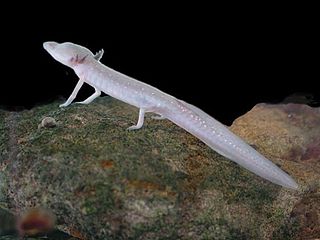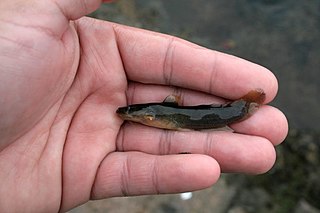
Catfish are a diverse group of ray-finned fish. Named for their prominent barbels, which resemble a cat's whiskers, catfish range in size and behavior from the three largest species alive, the Mekong giant catfish from Southeast Asia, the wels catfish of Eurasia, and the piraíba of South America, to detritivores, and even to a tiny parasitic species commonly called the candiru, Vandellia cirrhosa. Neither the armour-plated types nor the naked types have scales. Despite their name, not all catfish have prominent barbels or "whiskers". Members of the Siluriformes order are defined by features of the skull and swimbladder. Catfish are of considerable commercial importance; many of the larger species are farmed or fished for food. Many of the smaller species, particularly the genus Corydoras, are important in the aquarium hobby. Many catfish are nocturnal, but others are crepuscular or diurnal.

The flathead catfish, also called by several common names including mudcat or shovelhead cat, is a large species of North American freshwater catfish in the family Ictaluridae. It is the only species of the genus Pylodictis. Ranging from the lower Great Lakes region to northern Mexico, it has been widely introduced and is an invasive species in some areas. The closest living relative of the flathead catfish is the much smaller widemouth blindcat, Satan eurystomus.

The widemouth blindcat is a species of North American freshwater catfish endemic to Texas in the United States. It is the only species in the genus Satan.

The Ictaluridae, sometimes called ictalurids, are a family of catfish native to North America, where they are an important food source and sometimes fished for sport. The family includes about 51 species, some commonly known as bullheads, madtoms, channel catfish, and blue catfish.

Loricariidae is the largest family of catfish, with 92 genera and just over 680 species. Loricariids originate from freshwater habitats of Costa Rica, Panama, and tropical and subtropical South America. These fish are noted for the bony plates covering their bodies and their suckermouths. Several genera are sold as "plecos", notably the suckermouth catfish, Hypostomus plecostomus, and are popular as aquarium fish.

The Texas blind salamander is a rare and endangered cave-dwelling troglobite amphibian native to San Marcos, Hays County, Texas, specifically the San Marcos Pool of the Edwards Aquifer. This species resembles the olm, another stygofaunal salamander from Europe. Unlike the olm, this amphibian's body is not as elongated, and also has less reduced digits on its limbs.
A blind fish is a fish without functional eyes. Most blind fish species are found in dark habitats such as the deep ocean, deep river channels and underground.

Ameiurus is a genus of catfishes in the family Ictaluridae. It contains the three common types of bullhead catfish found in waters of the United States, the black bullhead, the brown bullhead, and the yellow bullhead, as well as other species, such as the white catfish, which are not typically called "bullheads".

Madtoms are freshwater catfishes of the genus Noturus of the family Ictaluridae. It is the most species-rich family of catfish in North America, native to the central and eastern United States, and adjacent parts of Canada. Their fin spines contain a mild venom with a sting comparable to that of a honey bee.
The toothless blindcat is a species of North American freshwater catfish endemic to Texas in the United States.

The yellowfin madtom is a species of fish in the family Ictaluridae endemic to the southeastern United States. Historically, the yellowfin madtom was widespread throughout the upper Tennessee River drainage, but was thought to be extinct by the time it was formally described.

The frecklebelly madtom is a species of fish in the family Ictaluridae endemic to the United States. Madtoms are in the genus Noturus, which is a group of catfish prevalent in North America. In 2023, the Upper Coosa River distinct population segment (DPS) of N. munitus was listed as federally threatened under the Endangered Species Act of 1973.
The Caddo madtom is a species of fish in the family Ictaluridae endemic to the United States. N. taylori was named in honor of William Ralph Taylor, U.S. National Museum, in recognition of his contributions to the knowledge of catfishes. They average 2 to 4 inches long and weigh no more than a few ounces. N. taylori has a small to tiny, fragmented range, but is mostly found in the Caddo, Ouachita, and Little Missouri Rivers in southwestern Arkansas. Ecological studies indicate that dam and bridge construction poses barriers to dispersal and migration of fish in the Ouachita Highlands. IUCNredlist.org states that better information is needed on life history, reproductive biology, and ecology of the Caddo madtom. This species is listed as endangered on the IUCN Red List. Limited range makes this species vulnerable to habitat destruction/degradation from impoundment, pollution, and other factors. Robison and Buchanan (1988) stated, "this rare species should be considered threatened due to loss of habitat". Warren et al. (2000) categorized the species as "threatened".
Prietella lundbergi is a species of North American freshwater catfish endemic to Mexico. It is a troglobitic species found in caves of the Tamesi River drainage. This species grows to a length of 4.5 centimetres (1.8 in) SL.
The Mexican blindcat, in Spanish bagre de muzquiz, is a species of North American freshwater catfish. Until recently, it was believed to be endemic to Coahuila in the Rio Bravo drainage in northern Mexico; however, in 2016 the species was reported from the Amistad National Recreation Area, Texas, following earlier, unconfirmed sightings of blind, white catfish in the area. The captured specimens were brought to the San Antonio Zoo and Aquarium.

Cavefish or cave fish is a generic term for fresh and brackish water fish adapted to life in caves and other underground habitats. Related terms are subterranean fish, troglomorphic fish, troglobitic fish, stygobitic fish, phreatic fish and hypogean fish.
The mountain madtom is a North American species of temperate freshwater fish belonging to the Noturus genus of the family Ictaluridae. The species was first described to the United States National Museum by Professors Jordan and Gilbert in the Big Pigeon River. The mountain madtom has a body that is characterized as being robust, and by the toxic sting that is associated with their pectoral and dorsal spines. Currently, the Pigeon River Recovery Project is working to try to restore the mountain madtom population that was lost in fisheries. Aside from the Pigeon River Recovery Project, there is little management being applied to this species, and it is currently listed on the threatened species list for the state of Tennessee.

Noturus fasciatus is a rare freshwater fish native to the U.S. state of Tennessee. It was first described as a species separate from Noturus crypticus in 2005. It is restricted to the Duck River system and is also found in two minor tributaries on the lower section of the Tennessee River. This species dwells in small to medium-sized streams where they can be found under gravel, rubble, and slab rock. They feed mostly on insects such as: stone, cattus and mayfly larvae.

The brindled madtom is a small catfish of the family Ictaluridae that is native to the eastern United States.

The freckled madtom a species of freshwater madtom (catfish) found in the eastern United States. The freckled madtom is a benthic feeder mostly of invertebrates and usually inhabits waters that are medium to large in size, living mostly in riffle areas that have mostly clear waters and rocky bottoms. Its spawning season occurs from spring to early summer in riffle areas, and sexual maturation occurs after two years.













